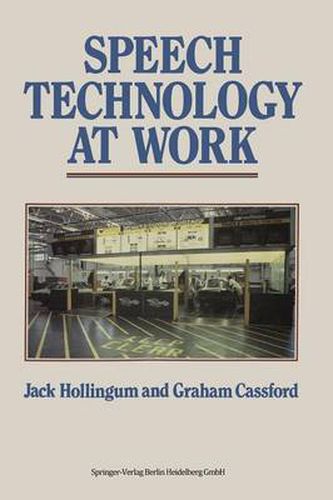Readings Newsletter
Become a Readings Member to make your shopping experience even easier.
Sign in or sign up for free!
You’re not far away from qualifying for FREE standard shipping within Australia
You’ve qualified for FREE standard shipping within Australia
The cart is loading…






This title is printed to order. This book may have been self-published. If so, we cannot guarantee the quality of the content. In the main most books will have gone through the editing process however some may not. We therefore suggest that you be aware of this before ordering this book. If in doubt check either the author or publisher’s details as we are unable to accept any returns unless they are faulty. Please contact us if you have any questions.
Speech technology - the use of speech as a means of sending information to, and receiving information from computer systems has been in use as a research tool for many years. Only recently has it begun to move out of the laboratory and into commercially worthwhile applications, first with compressed and synthesised spoken messages, then with computer recognition of spoken messages, and today with diverse applications involving both recognition and reproduction of human speech. We have written this book because we believe the technology has now advanced to the point where many more applications of voice recognition and response are both feasible and economically attractive. Computers that can understand everyday speech are still a distant prospect, but provided the limitations of present day equipment are clearly understood there is much that can be achieved with it. Our aim is to show, in non-technical language, what is now possible with the help of speech technology. The text includes many examples of current applications in industry, commerce and other fields, and we have selected five current industrial applications combining speech recognition and response for more detailed attention. Industrial cases have been chosen both because we see industry as an important growth area for speech applications in the next few years, and because it presents some of the greatest difficulties in speech recognition - if you can make it work in industry, then you can make it work almost anywhere.
$9.00 standard shipping within Australia
FREE standard shipping within Australia for orders over $100.00
Express & International shipping calculated at checkout
This title is printed to order. This book may have been self-published. If so, we cannot guarantee the quality of the content. In the main most books will have gone through the editing process however some may not. We therefore suggest that you be aware of this before ordering this book. If in doubt check either the author or publisher’s details as we are unable to accept any returns unless they are faulty. Please contact us if you have any questions.
Speech technology - the use of speech as a means of sending information to, and receiving information from computer systems has been in use as a research tool for many years. Only recently has it begun to move out of the laboratory and into commercially worthwhile applications, first with compressed and synthesised spoken messages, then with computer recognition of spoken messages, and today with diverse applications involving both recognition and reproduction of human speech. We have written this book because we believe the technology has now advanced to the point where many more applications of voice recognition and response are both feasible and economically attractive. Computers that can understand everyday speech are still a distant prospect, but provided the limitations of present day equipment are clearly understood there is much that can be achieved with it. Our aim is to show, in non-technical language, what is now possible with the help of speech technology. The text includes many examples of current applications in industry, commerce and other fields, and we have selected five current industrial applications combining speech recognition and response for more detailed attention. Industrial cases have been chosen both because we see industry as an important growth area for speech applications in the next few years, and because it presents some of the greatest difficulties in speech recognition - if you can make it work in industry, then you can make it work almost anywhere.